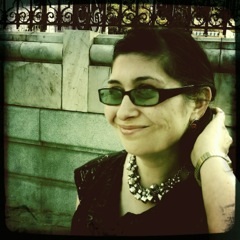Making the invisible visible
Tuesday 14:30-15:00 (2), Darwin Suite
Type: Lightning talk
Theme: Academic practice, development and pedagogy
http://feltlikeit.wordpress.com/category/phd-research/ #oer14 #abs63Authors
Ms Joanna Neil, PhD Interdisciplinary and Educational Research Student University of Glasgow; Lecturer Textiles, Fashion, Interiors and Design, University Centre Blackburn College, [email protected]Abstract
My interests lie with the creative design process and how technology can be used to support and enhance a more critically reflective practice.‘Making the invisible visible’ is on-going practice-led research where audio and visual technologies have been used to capture the process of creating, reflecting on and making a piece of work. All parts of the documented, and now visible process, are becoming the work; with the captured process being incorporated into the art work itself using innovative technologies. The final piece produced will literally be the sum of its parts and include what is visually produced as part of this process as well as what is usually invisible. The piece is on-going but an artwork for exhibition is planned for 2014. This auto-ethnographic process has enabled me to observe my creative practice, gain insight into a creative process, and consider the benefits of documenting, reflecting, and using recall techniques.
I have found that through using voice and visual recording in-depth reflections have taken place. I have observed a significant emphasis throughout my process on dialogue - internal dialogue as well as conversations with others. Digital technologies have helped construct, share and access on-going reflection and made them more visible.
Observing myself making an observational drawing gave me insight into the length of time I spent looking at my drawing compared to the image I was using for the drawing. The rapid movement between ‘artifact’ and created image, how this changed over the fifteen minutes of creating it, enabled me to think about my own relationship to the act of drawing and recording, in a more intimate way. Observing the self in the act of making a drawing allowed me to consider my markmaking, where I focus, make corrections, adjustments, pace myself, and my on-going thought process.
The research indicates that using technologies to document creative processes has a potential impact on how we teach and learn from the creative process. Using technologies to stimulate recall, observe and respond to what is often hidden, are powerful teaching and learning devices for the maker and potentially others.
The creation of artworks can seem mystical to outsiders, and portrayed in this way by artists who wish to keep their processes enigmatic. The presentation and exhibition of artworks can add to this mystery when accompanying text, narratives and titles are selective giving insight. Exposing or revealing the process is an attempt to de-mystify the creative process and make the thinking and development of a piece of work accessible.
Although there are potential issues regarding what we choose to share, how we share it, and with which communities we share with, this form of open practice is potentially a method for learners to explore how documenting and sharing their making process can enhance and develop their work. This approach encourages students to adopt performance type and documentary based practices for their reflective practice with a central question: How can technology best support a more analytical, critically reflective and visible process for creative practices.
References
Johansson, R., Holsanova, J. and Holmqvist, K. (2013. Using eye tracking methodology as a window to inner space. In: Paradis, C., Hudson, J. & Magnusson, U.: Conceptual Spaces and the Construal of Spatial Meaning. Empirical evidence from human communication. Oxford University Press, pp. 9–28.Kirk, C. and Pitches, J. (2013). Digital reflection: using digital technologies to enhance and embed creative processes. Technology, Pedagogy and Education, pp. 1-18.
Files
Recap recording
A recording of this presentation is available to view at https://campus.recap.ncl.ac.uk/Panopto/Pages/Viewer/Default.aspx?id=e8a03765-15eb-372e-dec3-e563c8c30a48 ©University Centre Blackburn College 2014 Joanna Neil cc-by 4.0
Further details
Keywords: reflection, dialogic, process, technology, creative, sharing, drawing, teaching, learning
Website: http://feltlikeit.wordpress.com/category/phd-research/
Ms Joanna Neil, Lecturer, University Centre Blackburn College
Twitter: @_feltlikeit
Twitter abstract: Technology supported and enhanced reflective practices: ‘Making the invisible visible'.
